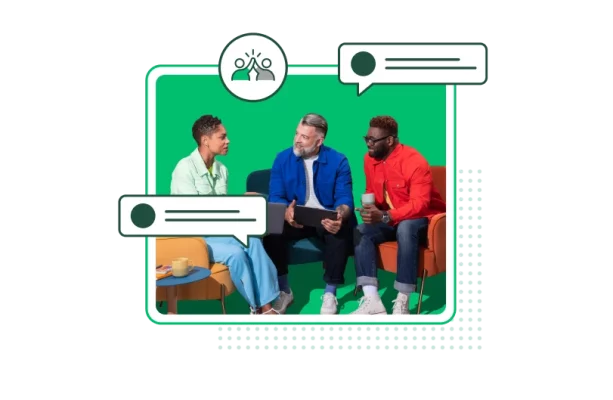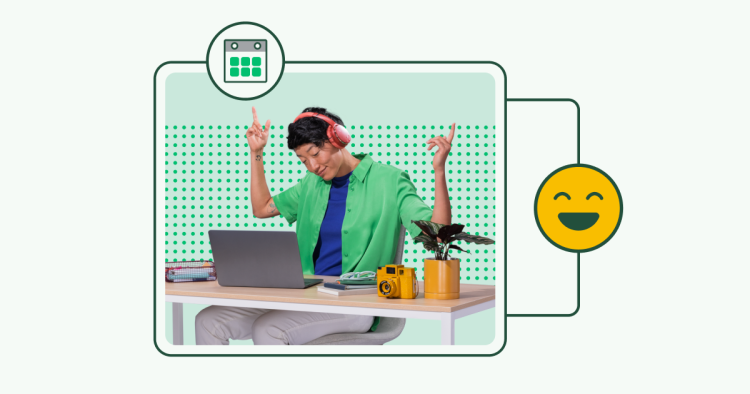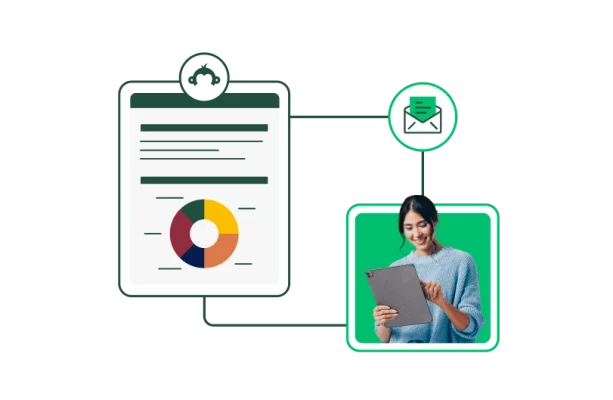How employee recognition programs work and why they matter

You know retaining high-performing employees is important as an employer or HR professional. But amid layoffs and job insecurity, even your best or most dedicated employees may seek other opportunities.
Gallup recently revealed that 51% of employees are considering leaving their jobs. And only 23% of employees strongly agree that they get the right amount of recognition for their work. Those numbers do not look good for employee retention and loyalty.
While you can’t fix this problem overnight, you can make progress by rewarding employees for their contributions. Why is employee recognition important? Our research shows that 82% of workers consider recognition an essential part of their happiness at work.
Organizations across industries use employee recognition programs to improve employee engagement and satisfaction. Keep reading to learn how to plan and launch a feedback-driven employee recognition program.
An employee recognition program allows businesses to praise the hard work of their top employees and thank workers for going that extra mile.
What is employee recognition?
Employee recognition is the process of acknowledging, celebrating, and sometimes rewarding employees for their work. This recognition is usually tied to a specific event or period when the employee exceeds performance expectations.
Why create an employee recognition program?
Applauding employees for a job well done can improve overall job satisfaction. However, to make employee recognition a keystone of your employee experience, you need to create a program that consistently celebrates employees' exceptional work.
Benefits of employee recognition
- Retain talent: You can build a healthy work culture by regularly giving employee recognition awards. Those rewards also have a big impact on employee engagement and retention. SurveyMonkey research reveals that 63% of employees who are always or usually recognized at work are unlikely to look for a new job in the next 3-6 months.
- Attract top talent: In a competitive job market, a strong employee value proposition can help your company stand out. Companies that commit to employee recognition will improve employer branding and are more likely to attract candidates.
- Decrease costs: Although employee turnover varies by organization, replacing an employee can cost up to 150% of that role’s salary. This makes sense when you consider the money that goes into recruiting for a role, interviewing multiple candidates, paying hiring bonuses, onboarding, and more.
- Reduce burnout: You can improve employee morale with an effective employee recognition program. Our research shows that 94% of employees who find their work meaningful and 93% of employees who are proud of their work haven’t experienced work burnout within the last six months. Those who have experienced burnout in the last six months say they don’t find their work meaningful (75%) and aren’t proud of their work (80%).
- Boost productivity: When you show employees you’re invested in them, they’re more likely to invest in you. A recent Gallup Poll reveals that highly engaged employees are 17% more productive and have a 41% lower absenteeism rate.

How to create an employee recognition program
Because an employee recognition program costs time and resources, you’ll need to show the potential impact of your work. Here’s how to prepare a results-driven plan that’ll help you get leadership buy-in and support.
Set goals and determine your scope
What does success look like for your employee recognition program? At a high level, success might mean increasing key employee satisfaction metrics like your employee Net Promoter Score® (eNPS). It’s the industry-standard employee loyalty metric that asks how likely employees are to recommend your company as a great place to work. (Make sure to add an open-ended question to your eNPS survey to capture any feedback about your employee recognition program.)
Similarly, you can use an employee engagement survey to monitor your program's impact on employee motivation and job satisfaction. You can benchmark employee engagement data and track how much employees agree or disagree with statements like:
- "I am inspired to meet my goals at work"
- "I am determined to give my best effort at work each day"
- "Management within my organization recognizes strong job performance"
You can also connect your program to HR metrics or Key Performance Indicators (KPIs) like employee retention and turnover. Tracking this data, plus employee feedback, can give you a fuller picture of your program’s impact.
After you set your goals, outline the terms of your program to determine its scope. Will you recognize employees every quarter, each month, or each week? Will this recognition be company-wide or private?
Create an outline of how managers can give praise. All recognition should be:
- Timely. Give praise after completing a project, not months after people have forgotten about it.
- Regular. Sporadic praise may feel like an afterthought. Be purposeful when constructing your employee recognition program.
- Visible. Making sure that other employees see you’re recognizing a particular employee can make them feel even more appreciated.
- Value-based. Words can be a great way to boost morale and make people feel like they are part of the team. However, there are many other ways of recognizing effort.
Decide how to give employee recognition
The next step is to figure out how you’re going to recognize employees for their great work. Before you decide on a reward structure and method for delivering feedback or praise, send an employee feedback survey. Your employees will likely have strong opinions on how they want to be rewarded.

Employees value and appreciate different forms of recognition. By asking for their feedback, you can offer employee recognition awards with a greater impact.
Types of employee recognition
- Top-down: A manager or senior leader recognizes an employee.
- Peer-to-peer recognition: Team members nominate their peers to be rewarded for their great work and contributions.
- Social recognition: Companies publicly praise an employee on a social media channel.
- Monetary recognition: A company rewards employees with a cash bonus or gift card.
Employee recognition examples and tools
You can combine each of these structures with a different reward, like a bonus, a recommendation for a promotion, a salary increase, or even public appreciation. You can also use several other formats of employee recognition or employee engagement ideas.
According to SurveyMonkey research, the most popular way to receive positive feedback is in 1:1 meetings. Other popular formats are team meetings and public messaging channels.
Here are some other employee recognition ideas for your organization:
- Regularly send employees an employee recognition survey, encouraging them to acknowledge their co-workers. You can run the survey regularly or link to it on the company wiki, always keeping it open for nominations.
- Implement a peer-to-peer recognition platform like Bonusly to make celebrating each other easy for your employees. Your employees can award points to a coworker, describe their contribution, and publicly thank them over your company’s messaging app.
- Feature an employee on your company blog or social media. Celebrating an employee’s achievements will make them feel proud, showing prospective candidates that the company truly values its employees.
- Of course, while verbal praise is powerful, many employees prefer monetary compensation. We found that 57% of employees want to be recognized with a cash bonus or raise. If you want your program to be effective, consider reinforcing your recognition with a gift, bonus, or special perk.
Set a budget and policies for your employee awards
The total budget that you create for your employee recognition program will impact the rewards you can offer. Before determining your overall rewards budget, you must factor in the cost of a survey platform or other recognition software.
You’ll also want to consider how much you can compensate employees by offering gift cards, a cash bonus, or something else.
At this stage, you should also outline the policies for your program. This policy will act as a centralized hub where employees can learn more about the incentive. You could also lay out how one employee can nominate the hard work of another or nominate their boss to the program.
Introduce your employee recognition program
It's time to launch once you build your program, set a budget, and implement the software and systems to help it run smoothly. Introducing the program is an exciting moment you should share with your employees.
Your business can send a company-wide email or have each department head introduce the employee recognition program to their respective teams. You can even kick off the program by recognizing and rewarding the first employee from each team or department.
Include references to the program in your onboarding or new employee training. Try to stick to the schedule or cadence you outlined on launch day. Regular announcements will motivate employees and build anticipation.
Track and analyze employee reward program results
Spotting key trends and shifts in your internal metrics will help you contextualize the success of your program. Make sure you answer these crucial questions about your program:
- Are we meeting the KPIs outlined in the planning stage?
- Has there been an improvement in employee productivity?
- Has there been a change in employee engagement?
- Are employees happy with the rewards we are offering?
Revisit and revise your program often
Upon successfully launching your employee recognition program, you’ll start to give out rewards and acknowledge the hard work that your employees contribute to your business. But this is only the beginning of the story. You’ll need to revisit your program to improve it over time.
Collect employee feedback regularly to see if your program is positively impacting or if you need to make changes. You can use employee pulse surveys, which are shorter surveys designed to give you quick insights. If you notice that several employees highlight an issue with the program, you can prioritize that problem for your next iteration.
Remember to share any responses to feedback that you act upon. This will show employees that you’re listening to their feedback and help further demonstrate your employee recognition program's success to stakeholders.
Boost employee engagement with a feedback-driven recognition program
Give your employees the appreciation they deserve, and they’ll be more likely to give you loyalty in return. Start by making employee recognition a core part of your workplace culture. Learn how SurveyMonkey helps you quickly collect employee feedback and gain the insights you need to boost employee engagement.
Net Promoter, Net Promoter Score, and NPS are trademarks of Satmetrix Systems, Inc., Bain & Company, Inc., and Fred Reichheld.
Discover more resources

HR toolkit: Make employee experience your competitive advantage
HR leaders can use this toolkit to help drive exceptional employee experiences.

State of Surveys: Top trends and best practices for 2025
Watch this webinar to explore 2025 survey trends, mobile insights, and best practices for optimizing your survey strategy.

How Americans feel about the Costco DEI policy: 25+ stats and 10 tips
68% of Americans back Costco’s DEI commitment. Explore 25+ stats on public sentiment around Costco, DEI policies, and the anti-DEI movement.

How to get more out of your employee engagement surveys
Learn how to design, analyze, and apply employee engagement surveys to drive meaningful change and improve workplace culture.